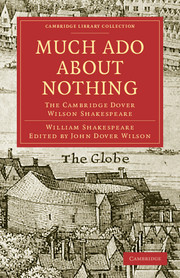INTRODUCTION
Published online by Cambridge University Press: 07 September 2010
Summary
This happy play, chiming to the echo of Balthazar's song, converts all sounds of woe—its editors' included—
Into Hey nonny, nonny.
Questions of text, of date, etc., can be accurately resolved, or at most, as Sir Thomas Browne would say, admit no wide solution. We treat them respectfully in our Note on the Copy [pp. 89—107]; but for our present purpose it suffices to summarise two conclusions:
(a) The text was first set up in print in 1600; in a Good Quarto, direct from the MS theatrical promptbook. A copy of this Quarto went back to the theatre to be used as prompt-book for later performances: and this same printed copy, scored with a number of prompter's jottings, went to Jaggard's office in 1622—3 to supply the Much Ado text in the First Folio. Here, then, in Quarto, we get, as nearly as anywhere in the canon, to Shakespeare's own manuscript; while the Folio bears traces of subsequent rehearsals—for the play was popular and must have been re-staged many times between 1600 and 1623. [See p. 108 below.]
(b) The date, then, is 1600 at latest; and it can scarcely be earlier than 1598, since Francis Meres' famous list, which appeared in that year, makes no mention of this successful Much Ado.
- Type
- Chapter
- Information
- Much Ado about NothingThe Cambridge Dover Wilson Shakespeare, pp. xi - xxxiiPublisher: Cambridge University PressPrint publication year: 2009First published in: 1923

